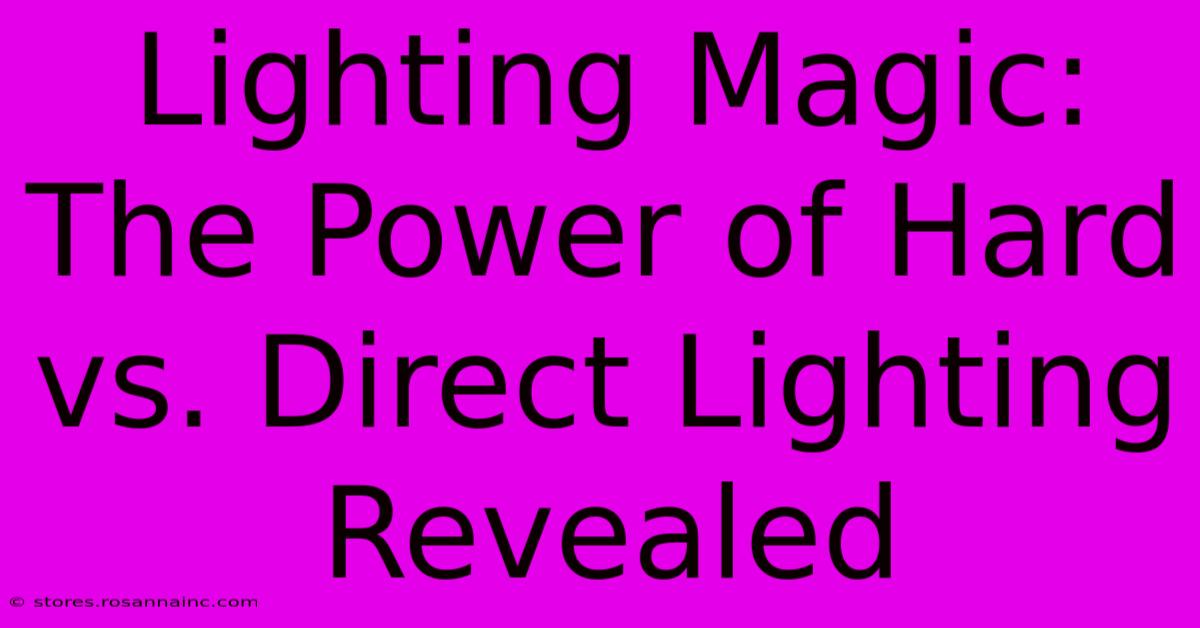Lighting Magic: The Power Of Hard Vs. Direct Lighting Revealed

Table of Contents
Lighting Magic: The Power of Hard vs. Soft Lighting Revealed
Lighting is the cornerstone of any successful photograph or film. It's the unseen hand that shapes mood, guides the eye, and tells the story. But understanding the nuances of lighting can feel overwhelming. This article delves into the fundamental difference between hard and soft lighting, exploring their distinct characteristics and applications to help you master the art of illumination.
Understanding Hard Light vs. Soft Light
The key difference between hard and soft light lies in the size of the light source relative to the subject. Think of it this way:
-
Hard Light: Created by a small light source positioned far from the subject, hard light casts strong shadows with sharply defined edges. The light creates a high contrast between light and shadow. Think of the harsh midday sun.
-
Soft Light: Produced by a large light source or by diffusing a smaller source, soft light creates gentle shadows with soft, diffused edges. The contrast between light and dark areas is much lower, resulting in a more even and flattering illumination. Think of an overcast day.
The Characteristics of Hard Lighting
Hard light, while often perceived as harsh, offers a unique set of aesthetic qualities:
Advantages of Hard Lighting:
- High Contrast and Drama: Ideal for creating dramatic portraits, emphasizing texture, and adding a sense of intensity to your images. The strong shadows add depth and dimension.
- Sharp Details and Definition: Hard light reveals fine details and textures in a way that soft light might not. This is particularly useful in product photography or when capturing intricate objects.
- Strong Direction and Focus: Hard light allows for precise control of light direction, allowing you to highlight specific features or create a specific mood.
Disadvantages of Hard Lighting:
- Harsh Shadows: Can be unflattering to people, creating dark, deep shadows that can obscure details and create an unattractive look.
- High Contrast: Can lead to blown-out highlights and crushed shadows, reducing the overall dynamic range of your image.
- Less Forgiving: Requires precise placement and control; mistakes are more readily apparent.
The Characteristics of Soft Lighting
Soft light, often described as more flattering and forgiving, provides a completely different aesthetic:
Advantages of Soft Lighting:
- Subtle Shadows: Creates gentle shadows, minimizing harsh lines and producing a more even and diffused illumination. This is often preferred for portraits and close-up shots.
- Lower Contrast: Produces a wider dynamic range, making it easier to capture detail in both highlights and shadows.
- More Forgiving: Less sensitive to precise placement, allowing for a more relaxed and experimental approach.
Disadvantages of Soft Lighting:
- Less Dramatic: Can lack the punch and drama of hard light, leading to images that appear somewhat flat or lacking in visual interest.
- Softer Details: Can soften details and textures, potentially reducing the sharpness and clarity of your image.
- Requires Larger Light Sources or Modifiers: Often necessitates the use of larger light sources, diffusers, softboxes, or reflectors.
Choosing the Right Light: Hard vs. Soft
The best lighting choice depends entirely on your subject matter, desired mood, and artistic vision.
- Portraits: Soft light is generally preferred for flattering portraits, creating a softer, more natural look. However, hard light can be used for dramatic or edgy portraits.
- Product Photography: Both hard and soft light can be effective depending on the product and desired outcome. Hard light may highlight texture, while soft light ensures even illumination.
- Landscape Photography: The type of light is largely dictated by the time of day and weather conditions, but both hard and soft light can be used to great effect. Golden hour (sunrise and sunset) often provides beautiful soft light.
- Still Life Photography: Similar to product photography, the choice depends on the desired effect. Hard light can create striking contrasts, while soft light maintains a more even tone.
Mastering the Art of Light: Experimentation is Key
Ultimately, mastering the use of hard and soft light involves experimentation. Don't be afraid to try different lighting setups, play with light modifiers, and discover what works best for your particular style and subject matter. Through practice and observation, you'll develop a keen eye for light and its transformative power. The possibilities are endless!

Thank you for visiting our website wich cover about Lighting Magic: The Power Of Hard Vs. Direct Lighting Revealed. We hope the information provided has been useful to you. Feel free to contact us if you have any questions or need further assistance. See you next time and dont miss to bookmark.
Featured Posts
-
Color Code Cracker Unlocking The Rgb Code For Pantone 1797 C
Feb 05, 2025
-
Pixelcut Pro Malfunction Paid Membership Remains Inaccessible
Feb 05, 2025
-
Journey To The Heart Of Lake District With Beatrix Potter An Immersive Morgan Library Experience
Feb 05, 2025
-
The Insiders Guide To Securing A Highly Coveted Position At The Morgan Museum
Feb 05, 2025
-
Literary Legends Live On Manuscripts And Letters That Defined American Literature At The Morgan
Feb 05, 2025
